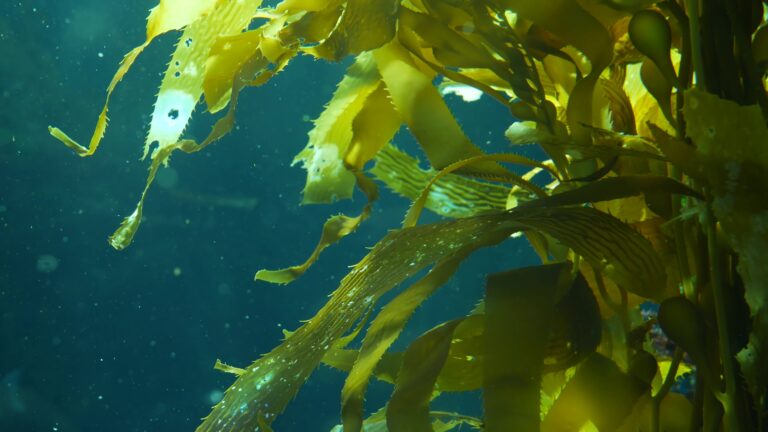Giant kelp

Algae have been considered superfood for quite some time and have now even developed into a real nutrition trend. They are said to have true superpowers due to their many valuable ingredients. The cosmetics industry is now also taking advantage of these. However, there are many different types of algae, and their properties and abilities differ greatly in some cases. One type of algae stands out particularly clearly from the rest: the giant kelp (Macrocystis pyrifera).
What is giant kelp?
Today, science knows more than 10,000 species of algae. They are scientifically divided into three groups: brown, green and red algae. Giant kelp belongs to the brown algae and is also called kelp. It is the largest sessile marine creature and can grow up to 45 metres. It is particularly abundant in the North Pacific, where it forms huge kelp forests, which in turn provide important habitats for countless marine creatures. Giant kelp usually grows at a water depth of between 6.0 and 20.0 metres. Its growth rate is truly impressive: under ideal conditions, it can grow up to 50 centimetres every day. Although giant kelp looks like a tree, it has no roots. Instead, it simply sits on the seabed.
The ingredients of giant kelp
Giant kelp belongs to the Laminaria family of algae and has a strong detoxifying effect. This is mainly due to the two algae polysaccharides alginate and fucoidan. Researchers have already been able to prove that alginate in particular can bind toxins such as heavy metals and remove them from the body. This applies primarily to mercury, barium, strontium, cadmium and caesium. Once the toxins have been bound, they are excreted very quickly. It is not without reason that the American Atomic Energy Commission classified giant kelp extracts as a protective substance against strontium-90 contamination after the Chernobyl reactor disaster in 1986. Since then, it has been recommended that people stockpile it in case of an emergency.
Furthermore, kelp contains a variety of minerals and trace elements that our body needs. Primarily, of course, iodine, but also sodium, potassium, sulfur, copper, magnesium, calcium and zinc. The high vitamin content is also interesting: giant kelp contains vitamins A, B1, B3, B5, B6, B9 and B12 as well as vitamins C and E.
The effect of kelp
Studies have already shown that kelp has a strengthening effect on the immune system and that the iodine contained in the algae can dissolve cysts in the female organism. The many valuable antioxidants contained in kelp can also prevent various diseases (including chronic inflammatory diseases, cardiovascular diseases and some cancers) and promote well-being.
Among other things, it is these antioxidants that make kelp interesting for cosmetic use, because they help the body and skin to fight oxidative stress and contribute to cell protection. The antioxidants in kelp neutralise dangerous free radicals and protect against cell damage. They can slow down the ageing process and, when used in cosmetics, have the ability to firm the skin and prevent the appearance of wrinkles and lines.
In general, serums and creams (whether day, night or eye creams) with giant kelp are able to improve the texture of the skin and provide valuable moisture. They can protect the elastin fibres and give the skin more elasticity and a more youthful appearance. In addition, kelp is considered to be very well tolerated by the skin.
The Environmental Working Group, an international non-profit organisation that maintains a database of more than 90,000 cosmetic products with Skin Deep, even classifies kelp (Macrocystis Pyrifera (Kelp) Extract) as very safe. The only thing that is not recommended is excessive consumption when giant kelp is consumed orally in the form of food supplements. This is due to the amount of iodine it contains: five grams of giant kelp already contains more than 250 µg of iodine.
However, there are no known risks or significant side effects associated with its external use, so there is no reason not to use it in cosmetic formulations. Quite the opposite: cosmetic products with kelp only have advantages for the skin and are a real treat for mature skin in particular! In this context, one aspect is particularly worth mentioning: if giant algae are injured or damaged, for example, they form a layer of mucus with which they repair the injury or crack. These unique self-regenerative powers can also be transferred to skin care: for example, for skin damaged by the sun!
Description of giant kelp
INCI: Macrocystis Pyrifera (Kelp) Extract
Description: extract of giant kelp
CAS number: 347174-92-9
Effect: detoxifying, antioxidant, anti-inflammatory, regenerative, cytoprotective
Applications: serums and creams, especially in the anti-ageing segment
A natural beauty booster with many advantages
Giant kelp contains a highly effective mix of valuable ingredients that have numerous positive effects on the skin. Among other things, the extract has a strong antioxidant and moisturising effect. It protects the cells, can promote the healing of sun-damaged skin and improve the skin’s texture so that it looks firmer and more youthful. Wrinkles and fine lines are less likely to develop or, if they already exist, may even fade away. As a completely natural active ingredient, kelp is therefore perfect for sophisticated, high-quality and well-tolerated cosmetics. If you are interested, please ask Cosmacon, we will be happy to answer your questions.